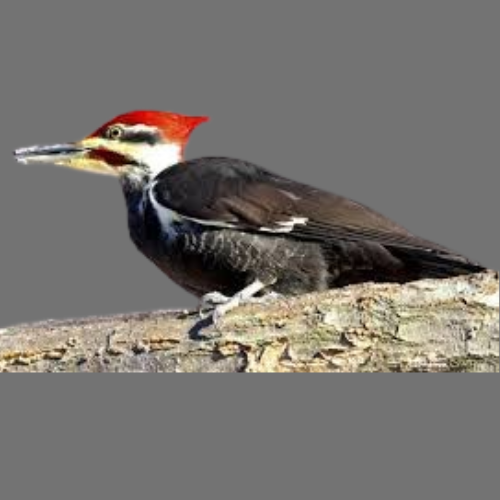Introduction to the Pileated Woodpecker
The pileated woodpecker (Dryocopus pileatus) is one of the largest woodpecker species in North America, known for its striking appearance and loud, distinctive call. This bird is often spotted in forests, both in rural and suburban areas, where it plays a vital role in the ecosystem by helping control insect populations and maintaining the health of trees. In this article, we’ll explore the pileated woodpecker call, what makes it unique, and how to identify it.
What Does a Pileated Woodpecker Call Sound Like?
Description of the Call
The call of the pileated woodpecker is one of the most recognizable sounds in North American forests. Often described as a loud, sharp “wick-a-wick-a-wick” sound, it can carry for long distances. This call is typically repeated in a rhythmic pattern, and sometimes the bird will make a long, drawn-out scream. The pileated woodpecker’s call is most prominent during breeding seasons but can also be heard year-round.
The loud call serves multiple purposes, including:
- Communication: Pileated woodpeckers use calls to communicate with mates and other woodpeckers in their territory.
- Territorial Defense: Their call helps warn other woodpeckers to stay away from their established area.
- Attracting Mates: During the mating season, male pileated woodpeckers use their call to attract females.
Variations in the Call
The call of the pileated woodpecker can vary slightly depending on the situation and the region. There are typically two main types of calls:
- The Contact Call: A short, rapid, and high-pitched “wick-a-wick-a-wick” that is often repeated several times.
- The Territorial Call: A deeper, more resonant sound that serves as a warning to other woodpeckers.
Additionally, pileated woodpeckers will also drum on trees, creating a hollow, rhythmic sound to communicate with others, which may overlap with their vocal calls.
Why Do Pileated Woodpeckers Make Such Loud Calls?
Territorial Behavior
As with many birds, the pileated woodpecker uses its loud call to establish and protect its territory. By calling loudly and consistently, a male woodpecker signals to other males that the area is already claimed. This territorial call serves as an auditory marker to avoid physical confrontations and reduce the need for more aggressive behaviors.
Communication and Bonding
The pileated woodpecker’s call is also an important part of its social behavior. Pairs often use calls to communicate with each other, particularly when foraging or during the mating season. These calls help maintain a strong bond between mated pairs and ensure that both partners remain aware of each other’s location.
Attraction and Mating
During mating season, male pileated woodpeckers will make louder, more frequent calls to attract females. The call serves as an indication of the male’s strength, fitness, and territory. A female woodpecker will assess the call’s frequency and intensity to determine the male’s suitability as a mate.
How to Identify the Pileated Woodpecker Call
Listening for the Call
If you want to identify a pileated woodpecker by its call, there are a few key features to listen for:
- Frequency: The pileated woodpecker’s call is usually repeated in quick succession. You may hear several “wick-a-wick” calls in a row.
- Pitch: The call has a high-pitched tone, but it can drop in pitch during territorial calls.
- Duration: Pileated woodpecker calls are often longer than other woodpecker species, especially when they are defending territory.
If you’re in a forested area, keep an ear out for these calls, particularly during early mornings and evenings when the birds are most active.
Visual Identification of the Bird
While the call is distinctive, you can also visually identify the pileated woodpecker by its size and features:
- Size: The pileated woodpecker is large, measuring 16 to 19 inches in length with a wingspan of about 26 to 30 inches.
- Color: It has a black body with a striking white underbelly and face. Its most prominent feature is the bright red crest on its head.
- Shape: The pileated woodpecker has a chisel-like beak, which it uses to drill into trees.
Where Can You Hear the Pileated Woodpecker Call?
Habitat of the Pileated Woodpecker
Pileated woodpeckers can be found in dense forests across North America, ranging from southern Canada to the northern United States. They prefer mature, mixed forests with large, dead trees, where they can find insects like ants and beetles. These woodpeckers are also known to live in suburban areas if there are enough trees and forests nearby.
In these habitats, you’re most likely to hear their call early in the morning or late in the afternoon. They may also drum on trees, making a distinctive hollow sound that often accompanies their vocal calls.
Best Time to Hear the Call
The best time to hear the pileated woodpecker call is during the breeding season, which generally occurs in the spring. However, they are also quite vocal year-round. If you live near a forest or wooded area, you may hear the call regularly, especially in the fall and winter months when other bird species are less active.
Other Birds with Similar Calls
While the pileated woodpecker’s call is distinctive, other woodpecker species may share similar sounds. Here are a few you might hear in the same habitats:
- Northern Flicker: Known for its call, which can sound like a harsh “wick-a-wick” or a series of loud, throaty “yip-yip-yip” sounds.
- Red-bellied Woodpecker: This species has a call that sounds like a “kwirr-kwirr-kwirr” and is often heard in forests and suburban areas.
While these species’ calls can be confused with the pileated woodpecker’s, the pileated’s call is generally louder and more forceful, and often repeated in rapid succession.
Conclusion
The pileated woodpecker call is an iconic sound of the forest, resonating through wooded areas with its loud and distinctive rhythm. This call serves many purposes, including territorial defense, mate attraction, and communication. Understanding the nuances of this bird’s call can enhance your appreciation of these magnificent creatures and their important role in the ecosystem.
Whether you’re an avid birdwatcher, an amateur nature enthusiast, or someone simply curious about the sounds of the wild, the pileated woodpecker is sure to capture your attention. The next time you’re in a forest, keep your ears tuned to its unmistakable call and look out for this remarkable bird!


